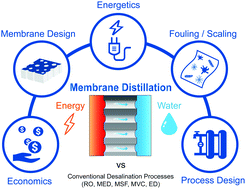当前位置:
X-MOL 学术
›
Energy Environ. Sci.
›
论文详情
Our official English website, www.x-mol.net, welcomes your
feedback! (Note: you will need to create a separate account there.)
Membrane distillation at the water-energy nexus: limits, opportunities, and challenges
Energy & Environmental Science ( IF 32.4 ) Pub Date : 2018-03-13 00:00:00 , DOI: 10.1039/c8ee00291f Akshay Deshmukh 1, 2, 3, 4, 5 , Chanhee Boo 1, 2, 3, 4, 5 , Vasiliki Karanikola 1, 2, 3, 4 , Shihong Lin 4, 6, 7, 8 , Anthony P. Straub 4, 9, 10, 11 , Tiezheng Tong 4, 6, 12, 13 , David M. Warsinger 1, 2, 3, 4, 5 , Menachem Elimelech 1, 2, 3, 4, 5
Energy & Environmental Science ( IF 32.4 ) Pub Date : 2018-03-13 00:00:00 , DOI: 10.1039/c8ee00291f Akshay Deshmukh 1, 2, 3, 4, 5 , Chanhee Boo 1, 2, 3, 4, 5 , Vasiliki Karanikola 1, 2, 3, 4 , Shihong Lin 4, 6, 7, 8 , Anthony P. Straub 4, 9, 10, 11 , Tiezheng Tong 4, 6, 12, 13 , David M. Warsinger 1, 2, 3, 4, 5 , Menachem Elimelech 1, 2, 3, 4, 5
Affiliation

|
Energy-efficient desalination and water treatment technologies play a critical role in augmenting freshwater resources without placing an excessive strain on limited energy supplies. By desalinating high-salinity waters using low-grade or waste heat, membrane distillation (MD) has the potential to increase sustainable water production, a key facet of the water-energy nexus. However, despite advances in membrane technology and the development of novel process configurations, the viability of MD as an energy-efficient desalination process remains uncertain. In this review, we examine the key challenges facing MD and explore the opportunities for improving MD membranes and system design. We begin by exploring how the energy efficiency of MD is limited by the thermal separation of water and dissolved solutes. We then assess the performance of MD relative to other desalination processes, including reverse osmosis and multi-effect distillation, comparing various metrics including energy efficiency, energy quality, and susceptibility to fouling. By analyzing the impact of membrane properties on the energy efficiency of an MD desalination system, we demonstrate the importance of maximizing porosity and optimizing thickness to minimize energy consumption. We also show how ineffective heat recovery and temperature polarization can limit the energetic performance of MD and how novel process variants seek to reduce these inefficiencies. Fouling, scaling, and wetting can have a significant detrimental impact on MD performance. We outline how novel membrane designs with special surface wettability and process-based fouling control strategies may bolster membrane and process robustness. Finally, we explore applications where MD may be able to outperform established desalination technologies, increasing water production without consuming large amounts of electrical or high-grade thermal energy. We conclude by discussing the outlook for MD desalination, highlighting challenges and key areas for future research and development.
中文翻译:

水能关系的膜蒸馏:局限性,机遇与挑战
高效的海水淡化和水处理技术在增加淡水资源方面发挥着关键作用,而又不会对有限的能源供应造成过大的压力。通过使用低级或余热使高盐度水脱盐,膜蒸馏(MD)有潜力增加可持续水的生产,这是水能关系的关键方面。然而,尽管膜技术取得了进步,并且开发了新颖的工艺配置,但MD作为一种高能效淡化工艺的可行性仍然不确定。在这篇综述中,我们研究了MD面临的主要挑战,并探索了改善MD膜和系统设计的机会。我们首先探讨如何通过水和溶解性溶质的热分离来限制MD的能量效率。然后,我们比较相对于其他淡化工艺(包括反渗透和多效蒸馏)的MD的性能,比较各种指标,包括能源效率,能源质量和结垢敏感性。通过分析膜性能对MD脱盐系统能量效率的影响,我们证明了最大化孔隙率和优化厚度以最小化能耗的重要性。我们还展示了无效的热回收和温度极化如何限制MD的能量性能,以及新颖的工艺变型如何设法减少这些低效率。结垢,结垢和润湿会对MD性能产生重大不利影响。我们概述了具有特殊表面润湿性和基于过程的结垢控制策略的新型膜设计如何增强膜和过程的耐用性。最后,我们探索了MD可能胜过现有淡化技术,增加水产量而又不消耗大量电能或高等级热能的应用。最后,我们讨论了淡化海水淡化的前景,强调了挑战和未来研发的关键领域。
更新日期:2018-03-13
中文翻译:

水能关系的膜蒸馏:局限性,机遇与挑战
高效的海水淡化和水处理技术在增加淡水资源方面发挥着关键作用,而又不会对有限的能源供应造成过大的压力。通过使用低级或余热使高盐度水脱盐,膜蒸馏(MD)有潜力增加可持续水的生产,这是水能关系的关键方面。然而,尽管膜技术取得了进步,并且开发了新颖的工艺配置,但MD作为一种高能效淡化工艺的可行性仍然不确定。在这篇综述中,我们研究了MD面临的主要挑战,并探索了改善MD膜和系统设计的机会。我们首先探讨如何通过水和溶解性溶质的热分离来限制MD的能量效率。然后,我们比较相对于其他淡化工艺(包括反渗透和多效蒸馏)的MD的性能,比较各种指标,包括能源效率,能源质量和结垢敏感性。通过分析膜性能对MD脱盐系统能量效率的影响,我们证明了最大化孔隙率和优化厚度以最小化能耗的重要性。我们还展示了无效的热回收和温度极化如何限制MD的能量性能,以及新颖的工艺变型如何设法减少这些低效率。结垢,结垢和润湿会对MD性能产生重大不利影响。我们概述了具有特殊表面润湿性和基于过程的结垢控制策略的新型膜设计如何增强膜和过程的耐用性。最后,我们探索了MD可能胜过现有淡化技术,增加水产量而又不消耗大量电能或高等级热能的应用。最后,我们讨论了淡化海水淡化的前景,强调了挑战和未来研发的关键领域。











































 京公网安备 11010802027423号
京公网安备 11010802027423号